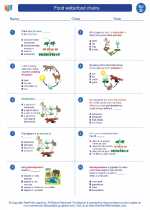Food webs/food chains -> chloroplasts
Chloroplasts
Chloroplasts are a type of organelle found in plant cells and some other eukaryotic organisms. They are responsible for the process of photosynthesis, which is the conversion of light energy into chemical energy in the form of glucose.
Structure of Chloroplasts
Chloroplasts have a double membrane structure, with an outer membrane and an inner membrane. Inside the inner membrane, there is a fluid-filled space called the stroma. Within the stroma, there are thylakoid membranes, which contain chlorophyll, the pigment responsible for capturing light energy.
Function of Chloroplasts
The main function of chloroplasts is to carry out photosynthesis. During this process, chloroplasts capture light energy and use it to convert carbon dioxide and water into glucose and oxygen. This process is essential for the survival of plants and the production of oxygen in the atmosphere.
Study Guide
- What is the main function of chloroplasts?
- Describe the structure of chloroplasts.
- What is the role of chlorophyll in chloroplasts?
- How does photosynthesis occur in chloroplasts?
- Explain the importance of chloroplasts for plant survival.
Understanding the structure and function of chloroplasts is crucial for understanding the process of photosynthesis and the role of plants in the environment.
Feel free to explore further or ask any more questions about chloroplasts!
[Chloroplasts] Related Worksheets and Study Guides:
.◂Science Worksheets and Study Guides Fourth Grade. Food webs/food chains

 Activity Lesson
Activity Lesson
 Worksheet/Answer key
Worksheet/Answer key
 Worksheet/Answer key
Worksheet/Answer key
 Worksheet/Answer key
Worksheet/Answer key
 Worksheet/Answer key
Worksheet/Answer key
 Vocabulary/Answer key
Vocabulary/Answer key
 Vocabulary/Answer key
Vocabulary/Answer key
 Vocabulary/Answer key
Vocabulary/Answer key
